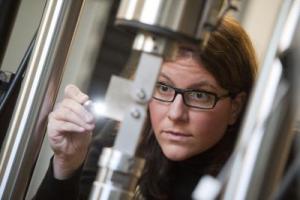Sep 15 2014
Diana Lados, associate professor of mechanical engineering at Worcester Polytechnic Institute (WPI) and founding director of the university's Integrative Materials Design Center (iMdc), has received a three-year, $424,000 award from the National Science Foundation (NSF) to support the development of a new way to manufacture metal-ceramic composites, which can be used to make vehicles lighter and more energy efficient, while significantly increasing their performance.
 This is Diana Lados, associate professor of mechanical engineering at Worcester Polytechnic Institute (WPI) and founding director of the university's Integrative Materials Design Center (iMdc). Credit: Worcester Polytechnic Institute.
This is Diana Lados, associate professor of mechanical engineering at Worcester Polytechnic Institute (WPI) and founding director of the university's Integrative Materials Design Center (iMdc). Credit: Worcester Polytechnic Institute.
The research will focus on materials known as ceramic-reinforced metal matrix composites, which are produced by incorporating small ceramic particles within aluminum to enhance its strength and high operating temperature. Manufacturers would like to use these light composite materials in cars, trucks, boats, and airplanes to increase their fuel efficiency without sacrificing strength and ductility, but current manufacturing methods cannot achieve the nanoscale size and uniform distribution of the ceramic particles necessary to fabricate parts that meet these requirements and perform well at both ambient and elevated temperatures.
With the NSF award, Lados, the sole principal investigator, will conduct fundamental and applied research aimed at developing a novel energy- and cost-efficient process for making nano-ceramic reinforced metal matrix composites, overcoming the limitations of existing processes, and enabling the creation of materials with unprecedented combinations of desirable properties and sustainability benefits.
"This project is another significant step in a large ongoing research program dedicated to developing novel materials and processes using a combination of fundamental materials science knowledge, property evaluations, and computational modeling," Lados said. "These materials and processes can help designers replace steel and cast iron in vehicles with lighter metals—including aluminum, titanium, and magnesium—to increase performance, reliability, and fuel efficiency. The ultimate goals of this work are to increase the nation's energy efficiency and reduce the emission of greenhouse gases, while also helping American manufacturers enhance their competitive edge."
Unlike current methods, in which the ceramic particles are mixed into the metal during processing, the new technique involves the formation of nano-reinforcements directly within the molten metal. The resulting composite materials will contain ceramic particles of the proper size, distributed uniformly in and firmly bonded to the metal matrix. Less expensive and more flexible and energy efficient than existing methods, the process can be used with a broad selection of metal-ceramic systems to manufacture a wide variety of structural components.
Previous work by Lados, which demonstrated the feasibility of the technique, was recognized with the 2011 Kalenian Award, which provides $25,000 in seed funding to support innovations by WPI students, faculty, and alumni. The current research will delve deeper into the fundamental mechanisms that drive the formation of the nano-scale ceramic particles and investigate their behavior and stability at elevated temperatures. Lados will also study the relationships between the microstructure of the composites formed with the new process and their mechanical properties, including fatigue and creep, which are critical considerations in structural and engine designs. She will also develop processing protocols that can produce the optimal microstructures and properties for various transportation applications.
This is the third NSF award Lados has received over the past two years. In 2012 she received a $525,000 CAREER Award, the NSF's most prestigious award for young faculty members, and she was a co-principal investigator on a $467,000 Major Research Instrumentation (MRI) grant that is funding the acquisition of high-speed cameras with quantitative stereo imaging and digital image correlation. She has also received significant funding from the U.S. Army and through iMdc, an industry-government-university research and educational alliance that she established and leads at WPI.
The iMdc consortium is dedicated to advancing the state of the art and practice in sustainable materials, process, and component design and manufacturing for high performance, reliability, and recyclability. Its more than 20 members include some of the world's largest manufacturing companies and several government organizations and national laboratories.In addition to her innovative work on metal matrix nano-composites, Lados is also conducting pioneering research on several other advanced technologies, including additive manufacturing, solid-state friction stir welding of similar and dissimilar materials, and cold spray processing. All these programs and venues provide Lados with nearly $1 million per year in research funding.